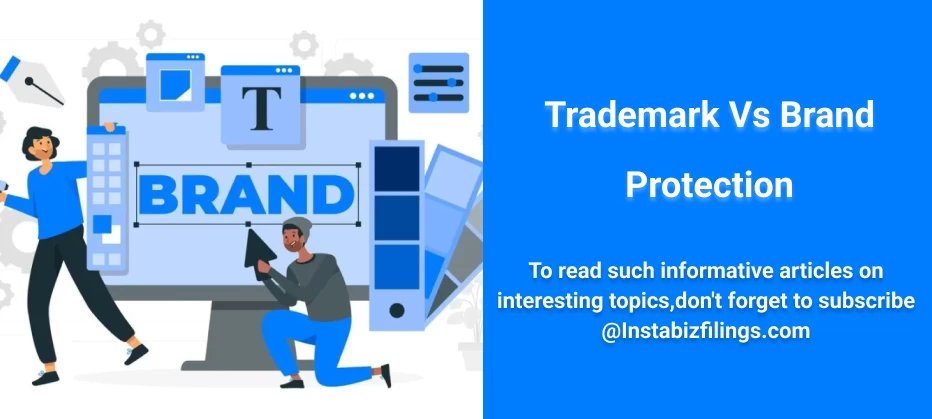
Trademark vs. Brand Protection
November 27, 2025 by Team Instabizfilings
Your business identity is something that must be safeguarded in a competitive marketplace, not by choice. Most companies believe that they can protect their brand through trademark registration and that it is that easy but this is not the case. Although the registration of trademarks is a strong initial action, the consistent control, enforcement, as well as strategic risk management is essential to protect the brands.
The following is a discussion in detail of where the compliance of trademarks ceases and wider brand protection takes place and when your business decides it has to go beyond mere registration.
Trademark Protection: The Foundation of Your Brand’s Legal Identity
A trademark is a signifier that is legally recognized to be your business. It may include:
-
Business names
-
Logos
-
Taglines
-
Product names
-
Unique symbols, sounds or even colours
What Trademark Registration Provides
-
The right to the exclusive right to use the mark in your industry.
-
Mechanisms to oppose copyright violators, imitators as well as dangerously similar branding.
-
Official registries, of whom you are the owner.
-
Availability of damages and penalties in the dealing with counterfeiters.
Registration of trademarks basically secures your right over your brand property as well as provides you with legal leverage in case of controversies.
Registration, however, does not provide sufficient security to your business in a world where infringement is possible on a global scale with instantaneous anonymity.
The Limitations of Trademark Registration
Registration of a trademark does not necessarily:
-
Surveillance of violation around the internet.
-
Halt unauthorized sellers in e-commerce sites.
-
All the global supply chains should be prevented by counterfeit goods.
-
Guard against counterfeiting or fraud of your brand name.
-
Enforce your rights on social media, marketplaces, or domain registrations
-
Identify illegal applications in other nations where you are not registered.
Your trademark is a kind of security system you have installed but you can not stop burglars without observing and acting on it.
Brand Protection: A Holistic, Ongoing Strategy
Protecting a brand is much more than registering it. It involves all that a business does to identify, stop, and mitigate threats that may defame its brand, consumers or reputation.
Key Components of Brand Protection
- Marketplace and Online Monitoring
-
Scanning e-commerce sites (Amazon, Etsy, eBay) for counterfeit or unauthorized listings
-
Using your brand name or logo to find sellers.
-
Detecting product duplication or misrepresentation
- Social Media Monitoring
-
Identifying counterfeit accounts, impersonation ones, or phishing advertisements.
-
Discovering the abuse of your brand in hashtags, ads, or posts.
- Domain and Web Monitoring
-
Identifying typo-squatting domains (e.g. amaz0n.com)
-
Detecting phishing sites or fraudulent landing pages
- Anti-Counterfeiting Measures
-
Serialization, holograms, QR verification codes
-
Authentication systems of supply chain.
- Legal Enforcement Actions
-
Cease and desist letters
-
Marketplace takedowns
-
Recording and enforcing customs.
-
Litigation when necessary
- Reputation Protection
-
Tracking reviews, news, AI-generated, and brand mentions.
-
Quick reaction to dangerous fake news.
Brand protection turns a legal piece of paper, which is your trademark, to a living guard.
When Should a Business Go Beyond Registration?
Most of the businesses fail to realize that they require brand protection until it has been damaged. To be ahead of the game, increase your protection plan in case any of the following are the case.
- Your Brand Operates Online
-
Copycat websites
-
Fake social media pages
-
Counterfeiters
-
Unauthorized resellers
- You Use E-Commerce Platforms
-
Amazon
-
Shopify
-
Walmart
-
AliExpress
-
Etsy
Protection of the brand is required then. Duplicating and unauthorized listings is very prevalent.
- You Have a Growing Customer Base
-
More exposure
-
More value
-
More risk
Your branding can be copied by competitors or opportunists can seek to take advantage of the customer trust.
- You Sell Physical Products
- International counterfeit is a multi billion dollar issue. In case you are selling consumer goods, tech accessories, cosmetics, clothing or luxurious products, you are one of the ideal targets.
- You Expand into International Markets
-
The protection of trademarks is territorial.
-
You take a risk of entering into new countries without safeguarding your brand only to find that it has been already registered by another party or even worse, being used.
- Your Brand Is Being Misused
-
Same logos, same names appearing.
-
Complaints that are brought forward by customers on products that you have not sold.
-
Fake pages or scam ads
-
Questionable reseller behaviour.
In case any of these happen, then you have already passed the registration only stage.
How Trademark Registration and Brand Protection Work Together
|
Trademark Registration |
Brand Protection |
|
Legal ownership |
Active monitoring & enforcement |
|
One-time or periodic process |
Continuous surveillance |
|
Prevents legal disputes |
Prevents financial and reputational loss |
|
Foundation |
Ongoing strategy |
|
Necessary |
Necessary for growth |
A trademark is your legal anchor, but brand protection is your defensive force.
Practical Steps to Strengthen Brand Protection
- Register Your Trademark in Major Markets.
- Initial markets then grow as your business grows.
- Implement Continuous Monitoring
-
Online marketplaces
-
Social media
-
Domains
-
Competitors
- Create a Clear Enforcement Strategy
-
Counterfeiting
-
Reputation threats
- Utilize Platform Tools
-
Amazon Brand Registry
-
Meta Rights Manager
-
YouTube Content ID
- Protect Your Supply Chain
- Use authentication and anti-counterfeit technologies.
- Educate Employees and Partners
- Make awareness of brand usage rules and brand risk.
Conclusion
You need to broaden its registration of trademarks to total brand protection when:
-
Your company has a virtual presence.
-
You are selling goods which are subject to imitation.
-
Your brand value is on the rise.
-
You are entering into new markets.
-
You have already been abused or infringed.
Registration of trademarks provides you with rights, brand protection allows you to defend your rights.
Combined, they achieve a one hundred and two hundred per cent. insulation around your business name, or, in the law as well as the market.
Disclaimer
The information provided in this blog is purely for general informational purposes only. While every effort has been made to ensure the accuracy, reliability and completeness of the content presented, we make no representations or warranties of any kind, express or implied, for the same.
We expressly disclaim any and all liability for any loss, damage or injury arising from or in connection with the use of or reliance on this information. This includes, but is not limited to, any direct, indirect, incidental, consequential or punitive damage.
Further, we reserve the right to make changes to the content at any time without prior notice. For specific advice tailored to your situation, we request you to get in touch with us.


